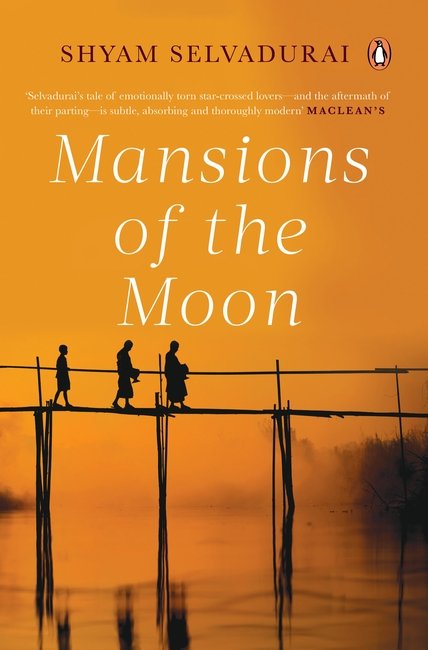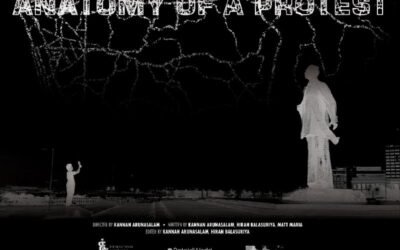Shyam Selvadurai’s Mansions of the Moon: A Lankan Review
Crystal Baines
The question of ‘woman’ in Buddhism has always rested on a paradox. On the one hand is the misogyny couched in the canon and in later monastic traditions which highlight women’s “subordinate” physical and mental constitution as reason to prohibit them from entering the Sangha. On the other hand, is the progressive register in the same canon and traditions which acknowledge women as relatively equal beings compared to their counterparts in other religious traditions in South Asia.
In his recent novel, Mansions of the Moon, Shyam Selvadurai tactfully engages with this paradox by reimagining the founding moments of the doctrine that is now Buddhism, through the eyes of Yasodhara, the wife of Siddhartha. The novel recreates the life of Yasodhara from her early years as the spirited young wife of the intellectually gifted and sanguine Siddhartha, to her grievous years as a bereft and vulnerable woman in a society with little to no social security for women without male guardians.
In the introduction to the novel, Selvadurai acknowledges the long legacy of the Buddha biography, from Aśvaghoṣa’s Buddhacharita to Edwin Arnold’s Light of Asia, which inspired his own retelling of the Yasodhara story. What stands out about Selvadurai’s retelling, compared to its other Anglophone counterparts in the global Buddhist sphere, is that the core characterisation, especially of the women in the novel, is influenced by a distinctly Sri Lankan Sinhala and Pali literary tradition. This review offers a brief overview of those sources which a Buddhist-familiar Lankan audience would recognise in the women’s world of Mansions of the Moon.
It should be established first and foremost that Mansions of the Moon (hereafter Mansions) is a fictional reimagination of the characters and incidents in the Buddhist canon, its accompanying later literatures, and their associated historiographies. It is Selvadurai’s own spiritual reckoning and appreciation of Buddhism beyond its violent and politicised manifestations from his childhood in Sri Lanka. It emerges from years of research into the political, cultural, and philosophical structures that shaped the lives of the people in the ‘Middle Country’ (North Central Indian subcontinent) in the sixth century BCE. The narrative traces the historical circumstances, political structures, and philosophical processes that led to the formation of ‘the Middle Way’.
At the novel’s beginning, Siddhartha’s father, Suddhodana is leader of the Sakiya republic with the question of succession open to contention. The Sakiya region, where most of the plot unfolds, is an oligarchic vassal state under the empire of Kosala. The leader of the state is voted in by a council of nobles called the ‘sangha’. It is also a time of great intellectual ferment where more than 62 systems of thought complement and contend with the Brahminic hegemonic order. Geographically, the ‘Middle Country’ is situated at a significant crossroads with dynamic trade relations stretching as far as Greece. The novel traces how the effects of these combined political and economic formations lead to the rapid rise of the merchant caste and courtesan industry, who as prototypes of a capitalist class, play a powerful role in the patronage of the new systems of thought.
Perhaps due to this attention to historical detail, Mansions is often described as a historical novel. However, as with his predecessors in the Sri Lankan and South Asian literary context, Selvadurai is not interested in recreating history, historiography, or canon. His poetic license, commitment to contemporary social aspirations, and deference to the tenets of Buddhism, rather than an obligation to historical or canonical accuracy, shape the characterisation and crucial events of this familiar tale. Metaphors, allegories, and tenets of the Pali and later Buddhist sources are weaved effortlessly into the poetics of this social realist novel.
For instance, Dukkha, the fundamental principle from which the doctrine emerges, is both the overarching theme and literary device which governs the characterisation and structure of the novel. The non-linear narrative consists of three chapters titled “Dukkha” which depict Yasodhara’s life of loss and grief after her husband’s departure to become “the Awakened One” (the honorific used by the characters in the novel to refer to the Buddha). Yasodhara’s narrative of Dukkha is interspersed with the story of her past as a hopeful young bride in Kapilavastu; a near-content housewife in agrarian Mudgala where Siddhartha is governor of the province; and finally, her anxious pregnancy during which time her apprehensions about Siddhartha’s ascetic intentions begin to unfold.
The principal source of inspiration for the character of Yasodhara in this novel is Ranjini Obeyesekere’s translation of the Sinhala Yasodharāvata and Yasodharāpadānaya. This becomes evident especially in scenes such as the “great renunciation” (mahābhinikmaṇa), where Yasodhara’s worst fears about her husband’s intentions are realised with the return of Channa, the charioteer. Suddhodana and her brother Devadatta deliver the dreaded news while Channa hands over to her “Siddhartha’s hair and jewels”, his last worldly possessions (Selvadurai 2023: 164). Her reaction in the novel unfolds as follows:
“Go after him, send your soldiers,” she’d scream at her uncle with a fierceness she wouldn’t have dared use before. “Send your spies into the jungle after him!” … She demanded to know how Siddhartha had seemed when the charioteer left him on the banks of the Anoma river. “Happy, Sāmini, happy”, the man replied with an apologetic wince. After that, she lost track of time and herself (ibid).
Excepting a few minor alterations, this scene resonates closely with the eighteenth or nineteenth century verse of the Yasodharāvata:
When the minister Canna returned to the city that day
The queen turned on him—a lioness leaping to the kill.
“Canna, friend, where is my loved lord today?
Go bring him to me now. I must see him. I will.” (Obeyesekere 2009: 4)
As with the folk poet of the Yasodharāvata, Selvadurai’s focus in the “Dukkha” chapters is on the mind, intellect, and emotions of Yasodhara the woman, whose expectations of marital life are altered again and again. Her feisty temperament, independent personality, and initial refusal to meekly accede to the wheel of change set in motion by her former husband is a complex embodiment of ‘delusion’ (moha), one of the ‘three poisons (akusala mūla) of Buddhism’.[1] Selvadurai explains in his introduction that this characterisation of Yasodhara in relation to an “unwholesome state of mind” (keles) is a way of paying homage to the old stories which incorporated the tenets of Buddhism into their narrative structures.
Her initial rage and depression gradually dissipate into despair and ultimately determination to save herself and fellow Sakiya women from a life of destitution. It is in her perseverance to secure some form of social protection for the women that Selvadurai’s Yasodhara differs from the docile and dutiful figure often featured in the cultural imagery of Sri Lanka. Following Siddhartha’s departure and Suddhodana’s death, a crisis unfolds in the women’s quarters of the palace. In the absence of male patronage, the women are left with only three options for survival: a courtesan life; bonded servitude; and exiled isolation in a remote region of the kingdom.
It is from this point onwards that Mansions is particularly committed to a feminist revisioning of the story of Yasodhara and the hagiographic portraits of the ‘first Buddhist women’. The implicit inquiry in the narrative from here on is, when we speak of the doctrine of the Middle Way, ‘whose dukkha’ are we really talking about?
With Yasodhara as the focal point, Selvadurai purposefully recreates the women’s world of the Buddha biography, an otherwise shadowy realm in Buddhist literary history. In the courtesan houses and women’s quarters of the palace, we meet familiar figures such as Sundari Nanda, Mitta, Ambapali and the great Prajapati Gotami, the founders of the Bhikkhuni order and ‘first Buddhist women’.
Literary sources such as Ranjini Obeyesekere’s Portraits of Buddhist Women: Stories from the Saddharmaratnāvaliya, Susan Murcott’s translation of the Therīgāthā, and I. B. Horner’s Women under Primitive Buddhism, one of the first scholarly studies in English on women in early Buddhism, serve as blueprints to the women’s world in Mansions.
With the exception of folk and other non-canonical literatures, the women that feature in the canon are often already enlightened thérīs, serving as archetypes of the vices and virtues of Buddhism. But in the novel, specifically Selvadurai’s social realist form, they are ordinary relatable personalities with implicit survival skills.
Whether they are noblewomen, courtesans, farmers’ wives, or bonded slaves, the women in the novel demonstrate tact, unassuming intelligence, and subtle diplomacy to navigate their prescribed roles as obedient wives, caregivers, and human commodities. Perhaps except for the courtesans, who are influential businesswomen, the fate of all women are determined entirely by male intervention.
In other words, the pursuit of salvation to Siddhartha and the other men, is an act of desertion and betrayal to Yasodhara and the other women, exposing them to a life of vulnerable destitution. Inspired by these clues in the source texts above, Selvadurai demonstrates that the fate of women in that society served as the primary incentive to the founding of the Bhikkhuni order.
In the introduction to her famous English translation of the Therīgāthā, Susan Murcott drawing on Dhammapala, the sixth-century commentator of the Therīgāthā, recalls the tradition in which the Buddha made it extremely difficult for his foster mother Mahaprajapati Gotami to enter the order of the Sangha. A seldom acknowledged feature in the canon is that the majority of women in the anthology were formerly of Siddhartha Gautama’s court: women who lost their sense of identity when their primary patron set out on his spiritual journey (Murcott 1991: 26-27). Murcott notes that in their shared anxiety of being a woman without a web of family that provided them with an identity and security in society, the Sakiya women sought Prajapati’s advice and direction (ibid).
Though the Therīgāthā features many women who enter the order on their own accord, a majority enters the order either in the absence of a male guardian or to escape the abuse and suffering caused by patriarchal social norms. This aspect of the Therīgāthā, arguably the oldest surviving women’s anthology in the world, is featured in one of the most striking scenes in the novel: the women’s march from Kapilavastu to Vesali to convince the “Awakened One” to permit female ordination. However, in Mansions, it is Yasodhara and not Prajapati who leads the women on the long and arduous trek, at the conclusion of which her empathetic cousin and close confidant, Ananda, intervenes on the women’s behalf.
Selvadurai thus alludes to a perennially vexing question about Buddhism: how does one reconcile the misogyny of heterosexual male monasticism in the Buddhist canon with its universal emancipatory ethics? Indeed, for a Sri Lankan audience, usually familiar with the decorous sacred imagery of a harmonious Buddhist universe where all characters are good and beautiful, Selvadurai’s humanisation of Yashodhara, Siddhartha, and a spectrum of portraits from canonical and folk literatures, may seem atypical. Yet the enduring fascination with well-known sacred stories, legends, and folk tales lies in these very elements of unfamiliarity in the familiar tale.
The power of poetic license has engendered a long-enduring legacy of literary ‘retellings’ which revolve around female protagonists of the oral and written literatures of Sri Lanka and the larger subcontinent. As plays such as Henry Jayasena’s Kuveni and Kanchuka Dharmasiri’s Suparnaka demonstrate, these familiar female figures have entered a complex web of retellings where their narratives have been re-formed to articulate contemporary aspirations and grievances of 20th and 21th century readers. Similarly, Mansions of the Moon enters Sri Lanka’s centuries-long tradition of retelling the Buddha biography and Yasodhara’s story.
Despite my efforts to remain relatively ‘neutral’ in my reading of Mansions, focusing only on the poetics of influence, poetic license, Buddhist values etc. I cannot help but reflect on the significance of this novel within the socio-political framework of Sri Lankan literary history.
Prominent Sinhala novelist and literary critic, Martin Wickramasinghe[2] pioneered the rewriting of the Buddha biography in the genre of the social realist novel with his publication of Bavataraṇaya in 1973. A landmark text in Sri Lankan history, Bavataraṇaya launched a trend and market for popular Sinhala novels which fictionalised famous characters from the Buddha’s life and the Buddhist canon from the mid-1970s onwards. Jayasena Jayakodi, the most prolific author of this sub-genre in Sri Lanka, refers to these novels simply as ‘Buddhist literature’ or ‘Buddhist novels’ (Amarakeerthi 2022).
But one fundamental difference between Selvadurai and the Sinhala language writers is that for the latter, Buddhism and Buddhist literature is an inherited tradition while Selvadurai “rediscovered” this same tradition from a place of tragedy (one could call it Dukkha) in the island’s post-independence history. Much like the women in Siddhartha’s court, displacement and exile from home and hearth mark the beginning of his search for ‘the Middle Way’. One could argue that Selvadurai’s retelling of people’s literatures such as Yasodharāvata and Saddharmaratnāvaliya is a way of reclaiming a literary legacy that was lost to him in the mayhem of ethnonationalist politics.
Read in this context, Mansions of the Moon is an important novel that contributes to our understanding of what constitutes a ‘Buddhist novel’ and ‘Buddhist writer’. What is significant about this retelling is that Mansions emerges from a distinctly Sri Lankan legacy of Pali and Sinhala literature, even as its author is commonly identified as a ‘Sri Lankan Canadian’ ‘diasporic’ writer in Anglophone literary criticism.
Hence, the appearance of Mansions of the Moon in the wider literary history of Buddha biographies and Buddhist literature, pushes our contemporary socio-political boundaries which shape the categories of ‘Buddhist writer’ and ‘Buddhist literature’. While Buddhist identities and Buddhisms outside the category of ‘Sinhala Buddhism’ have been a permanent feature in Sri Lanka (see for instance, Sunil Ariyaratne’s Demaḷa Bauddhayā and Tessa Bartholomeusz’s ‘Buddhist Burghers and Sinhala Buddhist Fundamentalism’), they are seldom acknowledged if not completely ignored. Though a labelling of Selvadurai and his novel as ‘Buddhist’ could be delimiting, Mansions of the Moon encourages readers to broaden the boundaries of Sri Lankan literary history to consider how lived Buddhist traditions have a profound impact on individuals and communities erroneously regarded as distant from Buddhism.
Crystal Baines (PhD, UMass Amherst) is a researcher and lecturer of literature and literary history. Her current research focuses on twentieth-century narratives of the secular and Buddhist thought.
References
Amarakeerthi, Liyanage. (2022). “Humanizing Nationalism? Buddhist Humanism as an Antidote to Consumer Capitalism, Open Economy and Nationalism”. AISLS History Seminar Series. Available at https://www.youtube.com/watch?v=7LtQo1MDGKs&list=PLhjniJO6w59rS_l5dwoLEAlvgiDS9nHp8&index=6
Ariyaratne, Sunil. (2006). Demaḷa Bauddhayā. Colombo: S. Godage Publishers.
Bartholomeusz, Tessa. (1998). ‘Buddhist Burghers and Sinhala Buddhist Fundamentalism’. In Tessa Bartholomeusz and Chandra R. de Silva (Eds.). Buddhist Fundamentalism and Minority Identities in Sri Lanka (167-185). Albany: State University of New York Press.
Horner, Isaline Blew. (1930). Women under Primitive Buddhism: Laywomen and Alms Women. London: George Routledge and Sons.
Murcott, Susan. (1991). The First Buddhist Women: Translations and Commentaries on the Therigatha. Berkeley: Parallax Press.
Obeyesekere, Ranjini. (2001). Portraits of Buddhist Women: Stories from the Saddharmaratnāvaliya. Albany: State University of New York Press.
—. (2009). Yasodharā, the Wife of the Bōdhisattva: The Sinhala Yasodharāvata (The Story of Yasodharā) and the Sinhala Yasodharāpadānaya (The Sacred Biography of Yasodharā. Albany: State University of New York Press.
Selvadurai, Shyam. (2023). Mansions of the Moon. Haryana: Penguin Random House India.
Wickramasinghe, Martin. (1973). Bavataraṇaya. Colombo: Sarasa Publishers.
Notes
[1] Greed, delusion, and hatred (lōbha, mōha, dvēśa) are the three roots of unwholesome thought and action (akusala mūla). In the early canonical and folk moral tales akusala mūla were personified in stock human and supernatural characters who either overcame the unwholesome thought or were consumed by it.
[2] Wickramasinghe is also translator of the modern Sinhala version of the Therīgāthā titled Tērī Gī (1952).
You May Also Like…
Sri Lanka’s Pre-Presidential Election Politics: Uncertainty or Turmoil?
Jayadeva Uyangoda
The coming few months have the potential to produce major political changes in Sri Lanka. The presidential election is...
Anatomy of a Protest and Aragalaya Cinema
Hiranyada Dewasiri
The 2022 people’s uprising and occupation movement in Sri Lanka, widely known as the Aragalaya, was heavily documented...
The conjuncture in the crisis
B. Skanthakumar
“Aaranchiya Subhai!” (‘Await Good News’) read posters plastered across the country recently. It was the build-up to...




